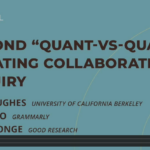
ALEX HUGHES
UC Berkeley
JENNY LO
Grammarly
WILL MONGE
Good Research
[s2If current_user_can(access_s2member_level1)]
[/s2If]
[s2If !is_user_logged_in()]
Please sign in or become an EPIC Member to access video.
[/s2If]
[s2If current_user_is(subscriber)]
Become an EPIC Member to access video:
→ Learn about Membership
→ Browse Video Library
[/s2If]
Overview
Qual and quant are so divided these days—by academic discipline, language, communities of practice, job titles. Too often, quantitative research is conflated with data science (or vice versa), and data science with optimization algorithms or simply engineering. In many organizations, being “data-driven” tends to define “data” with a narrow conception of enumeration and (mis-)conceptions about the kind of evidence that is suitable to act on.
This tutorial empowers ethnographers to develop more interdisciplinary programs of inquiry. First the instructors review fundamentals of quantitative research and provide tools ethnographers can use to evaluate...





